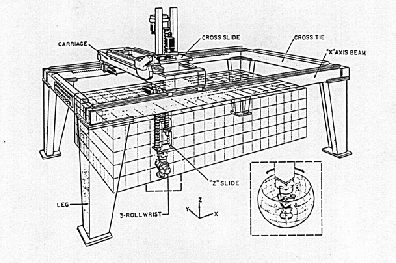Cartesian robots
Typical Cartesian robots have 3 linear axes of freedom which are perpendicularly oriented at each other. As you can understand, this ensures a working envelope in a form of a rectangular box.Of course, absolutely everything has its pros and cons. The same goes for this type of robots. I’ll start with the good things.

Because of their rigid structure, this type of robots usually can offer good levels of precision and repeatability. To ensure you that I don’t twaddle nonsense, I’ll give you an example. A 3-axes Cartesian robot – EPSON’s RP-HMSz have a repeatability +-0.01 mm for comparison – ABB’s smallest 6-axis robotic arm IRB 140 has “only” +- 0.03 mm.
OK, I admit that an articulated 6-axis robotic arm is not comparable to a 3-axis Cartesian, nevertheless, the Cartesian one is better in terms of repeatability. The reason why is quite obvious – the lesser axes, the lesser joints, the lesser joints, the better precision.
Theoretically, this type of robots are also easier to program. However, nowadays this argument could have lost its strength. I say so because usually robots’ manufacturers have their own software for their products and all computing and control is actually done “under the hood”.
As you can understand, Cartesian robots are the simplest of all stationary robots. Basically, it is even possible to build one by yourself. There are many manufacturers that supply either electric, either pneumatic linear modules – FESTO, EPSON, BOSCH are a few of them. Theoretically, you could buy components needed and assemble a Cartesian robot. This is where the programming issue would come in play. Although it is still far from easy, a Cartesian robot could be programmed “manually”.
And last but not least – pricing. Because of their relative simplicity, if compared to other types of robots that could do similar tasks, Cartesian robots are ought to be cheaper than their counterparts.
So what are the cons? Well, as you can imagine their work envelope is far from ideal. Also, the possibilities of tool orientation are very limited. Of course, it is possible to have a Cartesian robot with a 4-th rotary axis of freedom at the end of the vertical linear axis. Nevertheless, it still won’t be able to make movements needed for some tasks, like welding, for example. Also, its footprint can be quite large compared to other robots that could do the same task.
Taking these issues into consideration a conclusion can be drawn. A typical robot of Cartesian type can be the cheapest solution for simple pick and place operations. Also, it can be very effective for tasks where extensive tool orientation is not required or even better – if it should be avoided. For example – gluing, soldering, possibly sewing, pick and place operations etc.
Gantry robots
Yes, this topic even needs a separate headline. In many cases I have seen that gantry robots are not being explained separately of other Cartesian type robots. In my opinion this is wrong. Gantry robots should be discussed separately because of their distinctive structure and their possible applications.

Let me explain its structure. As you can see, movement along the x axis takes place between two beams which are directed in the x direction. The carriage on the y axis can move along it between aforementioned x axis beams. The tool can be lowered down from the carriage, thus forming the z axis movement. I agree – a bit messy explanation. Everything can be seen in the picture though.
The work envelope is similar with other robots of Cartesian type, however, a gantry robot usually encloses its work envelope from the outside. Also, worth mentioning is the fact that the only part of the robot that interferes with its work space is its z axis and the tool.
As you can see this robot stands firmly on four “legs”. If those legs are strong enough, the robot can lift very heavy weights. This is the most prominent use of a gantry robot – a lifter-mover. So, Gantry robots can be used for pick and place tasks that could include packaging, assembly and others.
There is one more interesting application for a gantry robot. It can be used as a platform for other robots. For example, a 6-axes robotic arm can be mounted upside-down as a tool on a gantry robot’s Z axis.
This is quite ingenious solution which can be used in a wide range of applications.
I hope I managed to give you some insight on Cartesian robots in general that could provoke further thoughts on this matter.
